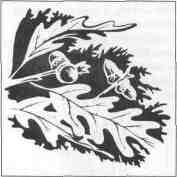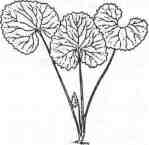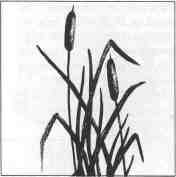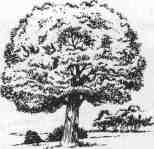 |
Home | Search | Browse | About IPO | Staff | Links |
 |
Home | Search | Browse | About IPO | Staff | Links |

The Name of the (non) Game by Fred Tetreault The name has been changed, but the aims are the same. Illinois' Non-game Wildlife Conservation Fund this year became the Wildlife Preservation Fund, but it remains the repository of monies donated for the benefit of wildlife that may not be hunted legally in the state, especially those species whose existence may be threatened or endangered. The fund will continue to derive its revenues from individuals interested enough in wildlife to donate something for its preservation, maintenance and enhancement. Such contributions may come to the fund at any time of the year as direct gifts from wildlife lovers, or they may be forwarded each year through the state income tax system. What has changed, it is hoped, is the public understanding of the fund's purposes. The Department of Conservation earlier this year sought — and in July, obtained — the name change to better communicate the objectives of the fund, which are to preserve and enhance the state's natural resources. Surveys conducted throughout Illinois last year indicated that while the public's awareness of the fund was greater than for any of those included on the state income tax form, a name change could significantly boost contributions. Whether this prediction comes to pass or not, the fund is the major source of funding for wildlife and habitats administered by Conservation's Division of Natural Heritage. Last year, Illinois taxpayers earmarked $167,000 for the state fund by marking Line 15a on their state income tax return. Since 1984, the fund has provided more than $2 million for wildlife projects. Wildlife Preservation Fund projects can run the gamut of the imagination. Following are some of them approved for the coming year or two. 38 * Illinois Parks & Recreation * January/February 1994 
Oak-Hickory Forests It is known that Oak-hickory forests in Illinois have been self-sustaining for the past 8,000 years. But current research indicates a change is underway. The stands are not regenerating as they did formerly. In fact, they are being invaded and replaced by shade-tolerant species, especially sugar maple, with consequent negative impacts on the birdlife and other forest wildlife traditionally found in the oak-hickory environments. Ecological factors underlying this change are not yet clearly defined, but it is believed the absence of wildfire may be a major contributor. However, fire's effects on forest regeneration and wildlife populations still are subjects of a hot debate that is hampered by a lack of reliable data. To test the significance of controlled burning and maple sapling removal on oak-hickory forest perpetuation and on the viability of forest bird populations, a three-year Illinois Natural History Survey project costing $17,700 annually has been approved for a $53,100 Wildlife Preservation Fund grant. The project will be conducted in Singing Woods, a 1,000-acre forest ecosystem within Peoria Park District's larger Peoria Wilds Project area. Emphasis of the bird studies will be on the troubled neotropical migrants, species such as warblers, thrushes, orioles, flycatchers and vereos, which migrate annually from tropical rainforests to Northern Hemisphere woodlands to breed. These species appear to be decreasing in Illinois and throughout the Midwest, and it is suspected the decline of oak-hickory forests may play a role.
Plans call for selective burning of portions of
the Singing Forest to remove their understory vegetation and convert the current closed-canopy configuration to the more open type of woodland that
predominated there in presettlement times.
Research questions to be researched and answered: What species of birds currently breed in the closed-canopy portions of Singing Woods and in the burned-over "conversion" areas, and what is their breeding success in each area? What effect does burning and conversion to more open woodlands have on species breeding in the closed canopy areas lying near the conversion sites? Do neotropical migrants respond differently from permanent residents or short-distance migrants to conversion management practices?
The majority of the project's costs will come
from the hiring of people to cut maple trees, monitor bird populations, net and band birds, locate nests
and for the training of these personnel.
Site M Study That's about to change. A $10,000 grant from the Illinois Wildlife Preservation Fund has been awarded to the Conservation Department's Division of Natural Heritage for a one-year study of the area. The large and diverse tract is believed to harbor a great variety of wildlife and vegetation, possibly including some rare, threatened or endangered species. A thorough inventory of the area's plant and animal groups and its habitat types will aid the Conservation Department in making decisions about the protection, management and restoration of the site's natural resources. Objectives of the project include completion of surveys of Site M's breeding birds and vascular plants, and the location, description and mapping of its natural communities. Illinois Parks & Recreation * January/February 1994 * 39 
Garlic Mustard Prevention With help from the Wildlife Preservation Fund, the Department of Conservation will test the effectiveness of burning against garlic mustard proliferation for two years at Sand Ridge. The project will receive $2,000 annually from the fund. Through data obtained in the study, DOC also hopes to evaluate the effect of prescribed burning on native vegetation and the impact of garlic mustard's uninhibited spread on native vegetation. Conservation's war on the harmful plant already has included several previous studies and efforts to eliminate it. An earlier two-year application of woodland fire failed to eradicate the troublesome weed, which also has demonstrated an ability to survive herbicides and even physical removal. Already known from previous projects is that garlic mustard produces chemicals which inhibit the growth of competing plants; that it is self-pollinating, meaning a whole population can derive from a single seed; and that it has adapted well to Illinois conditions and is spreading like wildfire. One encouraging note: the seed requires cool temperatures to germinate, suggesting temperature as the possible limiting factor in its spread. The plant doesn't appear anywhere in the state south of Interstate 70. The Department regards continuation of the burning program and information collection efforts at Sand Ridge State Forest to be critical. First, it be lieves additional data and experience are required to determine the effectiveness of prescribed burning as a garlic mustard control technique. Second, not enough is known about the effects of burning on other plants in the woodland understory and, therefore the potential exists for eradicating desirable herbs along with the unwanted weed.
The project will be undertaken during the annual Northeastern Illinois Wetland Survey for Endangered and Threatened Birds, to be conducted on selected wetlands by the Conservation Department's Division of Natural Heritage. It's aim will be to amass more quantitative information on breeding productivity than the yearly survey previously was designed to provide. A secondary focus of the project is the updating and upgrading of the annual wetland survey's electronic database to allow easier transfer of its information to the Natural Heritage division, to managers and regulating agencies. The work is part of the Conservation Department's overall effort to obtain reliable information on the abundance, productivity and breeding in endangered and threatened bird populations, which the agency needs to carry out its statutory mission of preserving those species. 40 * Illinois Parks & Recreation * January/February 1994 
New Wetlands A $7,500 award from the Wildlife Preservation Fund will aid a cooperative effort by the U.S. Fish and Wildlife Service and the Department of Conservation to create 150 to 750 acres of new wetlands on private property in Illinois during the coming year. Other funding will come from the Fish and Wildlife Service and from the Conservation Department's pheasant, furbearer and migratory waterfowl hunting stamp accounts. Each of the three stamp funds will invest $7,500 and the federal agency will add at least $45,000. The project continues for another year a program launched by the USFWS in 1989 that so far has developed 1,697 acres of wetlands on private land throughout the state. Conservation became a partner in the venture last year. With the help of Conservation's Nongame Wildlife Conservation Fund (since renamed Wildlife Preservation Fund), its migratory waterfowl, pheasant and furbearer stamp funds, and a $30,000 USFWS contribution, 280 acres of wetlands were created last year at 41 sites in 22 counties at a total cost of $97,968, or $350 per acre. An 11-inch by 14-inch sign recognizing the funding sources has been erected at each new wetland. The new areas range between one and 20 acres and provide excellent habitat for wetland-dependent wildlife. Frequently, they comprise the only permanent habitat in areas of extensive agricultural development. Department of Conservation private lands biologists will work with the Fish and Wildlife Service in developing the wetlands. USFWS will provide the equipment, supplies, personnel and engineering services for the project. To participate in the program, landowners must agree to maintain the wetland on their property for a minimum of 10 years.
Among the survey's objectives are to determine which of the trails on its natural properties are usercreated and which existed before the agency developed its current Forest Plan. The reason is that although the Plan allows trails, including those for equestrian use, on a site-by-site basis in its natural areas, it prohibits equestrian activities on user-created trails that existed before the Plan was adopted. The Forest Service currently has no comprehensive map or other records to determine which natural areas trails are user-created or when they were established. Other objectives of the project are to identify and map all trails on natural areas managed by the USFS; to document the trail network via photographs and measurements; and to provide management recommendations for handling the impacts of trail usage on the natural areas.
A definitive accounting of this suspected decline is lacking, however. Among the unknown Illinois Parks & Recreation * January/February 1994 * 41 and critical — factors is the status of a number of the state's historic populations. An $8,000 Wildlife Preservation Fund grant has been awarded for a survey to document the species' status and to determine if timber rattlers require the protection afforded by inclusion on state endangered or threatened species lists. The project will involve: field surveys of areas where the snakes historically have been found or where there is habitat — or a potential — for them to live; an estimation of the population size where timber rattlers are encountered; and a comparision of past and present distribution and abundance patterns. Members of the Conservation Department's Division of Natural Heritage will conduct the studies, which are expected to be completed this summer.
A $6,000 grant from the Wildlife Preservation Fund is financing the dual-faceted project, which is scheduled to be completed next summer. Primarily, the money is earmarked for the purchase of telemetry equipment, an essential part of the Illinois/Minnesota exchange agreement. The electronics will provide an opportunity for biologists to assess the success of the translocation program and to allow the birds to be recaptured and returned to Minnesota in the autumn of 1994. The radio telemetry research also will make possible an evaluation of current prairie chicken management activities at the preserves by identify ing which management areas are being used by the birds for nesting, brooding, foraging and roosting. In addition to meeting the requirements of the tranlocation agreement, goals of the project include the preparation of an evaluation of the translocation effort's success effort and development of a report on habitat use by the Minnesota prairie chickens as a way of evaluating current management strategies on the two sanctuaries.
"Duff" is the decayed organic matter that builds up through the seasons on the soil at the base of prairie plants. The material obstructs new growth and often is removed by fire. The project is being carried out by the Illinois Natural History Survey under contract with the Conservation Department. Its $27,000 cost has been divided equally among the three years of its duration. Objectives of the study are not only to document the effects of prescribed burning on insects living in the duff, but also to determine if those effects differ according to the timing of the burning. The Department of Conservation conducts prescribed burns in the spring, but prairie fires in presettlement days usually occurred in the fall. Other goals of the study are to develop an inventory of the tiny duff-inhabiting insects, learn when to time deliberate burns to avoid unnatural impacts on prairie insect species, determine the recovery rates of insect populations burned in different seasons and document the effects of unbumed patches on the recovery rates of these populations. 42 * Illinois Parks & Recreation * January/February 1994 
Lowden-Miller Natural Feature Survey A plant and natural feature survey now under way at the 2,225-acre Lowden-Miller State Forest near Oregon already has found three plants listed as endangered or threatened in Illinois, discovered a plant that may be a candidate for inclusion on the Federal Endangered and Threatened Species List, and mapped a number of previously-unsuspected relict plant communities, fens and prairie remnants. Department of Conservation natural heritage division biologists will complete the inventory late next summer with financial help from a $2,000 Wildlife Preservation Fund grant. The unique area's unusual geologic and soil conditions increase the likelihood that other rare plant populations and natural communities will be found there. Conservation purchased the site last year from descendents of its original owner and developer, former Illinois Governor Frank Lowden. As part of the project, Natural Heritage biologists are conducting intensive ground surveys of the forest in search of unique natural communities and endangered or threatened species; delineating plant and animal populations and their numbers on topographic maps; mapping and describing unique features or natural communities; and compiling useful management data and adding it to the Natural Heritage division's database. A similar project — an in-progress survey of birdlife at the Lowden-Miller site by Conservation's Division of Natural Heritage — also has been awarded a $2,000 grant. That work, too, was scheduled between July 1993 and August 1994. Little or no information exists on avian species utilizing the large, diverse and heavily-forested area. The site's birdlife, especially its breeding populations, must be inventoried to enable Conservation to competently manage them and the rest of the tract's natural resources. Such documentation also would make comparisons possible so that changes over time could be recognized.
Long considered a rare species in the state, the river cooter is a small river turtle once thought to have been extirpated from Illinois in the early 1980s. Recent studies, however, indicate the amphibian still exists throughout much of its historic range, though its numbers continue to be low. Moderate-size populations are believed to inhabit the backwaters of both the Wabash and Ohio rivers. The project, already underway and scheduled for completion next summer, will determine the cooler's status in the two river systems and provide the foundation for long-term monitoring of the species. Project methods include identifying which backwater areas have cooter populations, determining the species abundance in these areas, and marking the populations in one or two of the areas for use in long-term monitoring and population-estimating roles.
Decisions on the disposition of Illinois Wildlife Preservation Fund contributions are made by the Conservation
Department's Division of Natural Heritage with the help
of an 11-member committee appointed by the agency's
director.
The advisory panel is composed of representatives
from many of the Department's major constituency
groups. It meets once or twice a year to determine how
donations to the Wildlife Preservation Fund can be employed for the betterment of conditions for Illinois wildlife. This article was printed through a cooperative agreement with the Illinois Department of Conservation. It originally appeared in the January issue of Outdoor Illinois. Illinois Parks & Recreation * January/February 1994 * 43 |
|
Sam S. Manivong, Illinois Periodicals Online Coordinator |